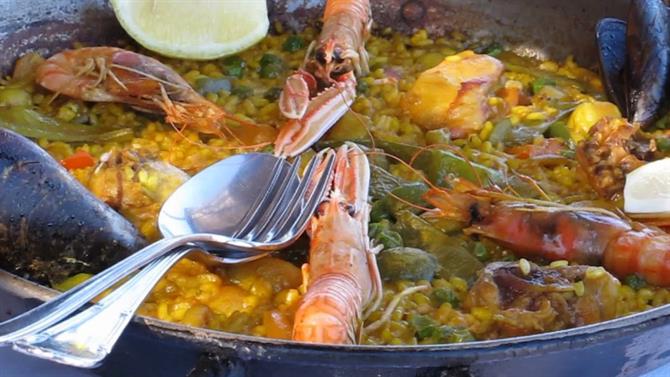This year, there is an even greater reason to be part of this historic event in Alicante as the pilgrimage is celebrating its 525th anniversary so it could be on course to attract even more participants. It is a very communal affair as everyone sets off together with plenty of food and wine enjoyed along the way.This year it will be held on Thursday May 1 when the 200,000 or more participants will meet at the San Nicolas Cathedral in Alicante at about 8am to walk the 7.5kms to the Santa Faz monastery (which translates as the monastery of the holy face).
All along the route, pilgrims are fortified with anise rolls and the local sweet mistela wine – a hearty breakfast by all accounts! No wonder the short walk takes two-and-a-half hours or more. Many pack their own picnics of local produce such as rabbit with tomato, tortilla and local wines for the road ahead.
Pilgrimage in honour of miracle
So just what does the pilgrimage represent? Although a fairly modest building by religious standards, the Santa Faz monastery houses a famous religious relic –a piece of cloth which Veronica used to wipe the face of Jesus as he made his painful way with the Cross to his Crucifixion. The cloth still bears an imprint of his face. Nowadays, the historic remnant only sees the light of day during a Mass held for the Santa Faz pilgrimage.The rest of the year, the cloth is held under lock and key in a special room behind the main altar.
The relic remained in Jerusalem until the 6th century when the Muslims took over the land. To keep the religious relics safe they were transfered to Cyprus and then on to Constantinople. However, in 1453 the city was taken by the Turks and the Emperor’s sons fled to Rome, taking the relics with them. Eventually they fell into the hands of Pedro Mena who had travelled to Rome to be appointed priest of San Juan, Alicante.
The cloth was also the centre of a miracle on March 17, 1489. After a year of extreme drought in the Alicante region, the priest Pedro Mena organised a procession offering prayers for rain. Taking the holy relic with them, it became heavier and heavier. It eventually became too heavy to carry and they stopped to see what was happening. They looked at the cloth to see a tear from the right eye running down the cheek. Soon after, the heavens opened and much-needed rain fell for a week. A miracle indeed!
Since then, the Santa Faz monastery has been a place of pilgrimage for people from all over Spain with many kings and heads of state praying at the altar.
The pilgrimage is an important part of the Alicante region’s rich culture with many local people taking part in the annual event. Many are casually dressed and chatter excitedly as they make their way to Santa Faz. Others walk barefoot and are silent, possibly in prayer or meditation.
What does Santa Faz have to offer?
Santa Faz is a small town on the outskirts of Alicante city so to have 200,000 pilgrims flocking to the area is a sight to behold. Much of the route is along the main N332 Avenida de Denia, which is closed to traffic all day so the pilgrims can pass safely. There are frequent buses to take them back to Alicante after their celebrations.
For four days, Santa Faz celebrates its special feast with hundreds of craft stalls and a fairground to entertain the thousands of visitors. Souvenirs from the stalls include typical products from Alicante such as ceramics, fresh food and sweets including nougat, pralines and candy apples. You can also pick up religious souvenirs showing replicas of the historic cloth.
The Baroque church where the religious relic lies dominates the little town and is in a typical Spanish square lined with little bars. You can visit the monastery throughout the year with opening hours being 9am to 1pm and 4pm to 8pm Mondays to Saturdays, and 9am to 1pm on Sundays and fiesta days.
During your stay in Alicante
Why not combine your pilgrimage with a long weekend in the beach city of Alicante?The city is easy to get around to explore its many museums, art galleries and shops. Hotels range from budget hostals to impressive four-star spa resorts.
The city is fairly compact and so can easily be explored in a couple of days with main attractions being the impressive Santa Barbara castle which looms over the town, the indoor market selling fresh fish, meat, fruit and vegetables, the MUBAG art museum, the Volvo Ocean Race museum, San Nicolas cathedral and the many shops including the famous El Corte Ingles department store.
Many fine restaurants can be found in the old town, along the beach or in the stylish marina. A great place for dining out is along the famous seafront promenade, the Explanada de España, which is made of coloured marble tiles to resemble waves and is lined with palm trees. Typical regional dishes to try include arroz a banda (rice in fish stock), paellas and fresh fish or shellfish straight from the fishing boats.

You may simply want to relax and enjoy a day on the sandy beach at Alicante or try one of the fabulous spa treatments in a top-class hotel or salon.Alicante-Elche airport is also just 11 kilometres from the city centre so it's a perfect spot for a weekend break.
